The Shadowfell is a mirror dimension buzzing with negative energies, particularly of the Necrotic school. Not even the might of a Dragon can resist its corruption, transforming into the unnerving Shadow Dragon from just a few years of exposure to the Plane of Shadows. Ever wonder what makes them a DnD Staple?
Don’t Fret; I have pondered this extensively! In this manic muse’s research, I have discovered several facts and ideas that make me eager to take on a Shadow dragon of my own one day!
Shadow Dragons fit in that unwritten category of monster, which, based on party level, can act as your tone-shifting Big Bad eater. The Underdark is incredibly cut-throat, after all. Not even Mindflayers are safe around a rampaging Fell-infused Dragon.
So… What the Fell is a Shadow Dragon, then? Welcome to a Shadow Dragon 5e Guide.
Shadow Dragons; Entropic Draconic, Necrotic Department
A Shadow Dragon is formed from any other type of dragon, excluding a Dracolich, spending a prolonged period in the Shadowfell. This corruption places a template on the preexisting dragon’s stat block.
This template adds advantages surrounding dark terrain. Unfortunately, it also adds disadvantages in lit terrain. This is made up for by getting to replace their breath weapon with one that deals Necrotic Damage while threatening to transform the corpse into an Undead Shadow.
Once corrupted, the template stays on the dragon even if they leave the Shadowfell. This leads to their personality shifting. Their instincts adjust to slinking in shadows and favoring the underground. All the while, the dragon will feel unnaturally drawn back to the Shadowfell.
- Shadow Dragons are not a breed but a template that any species of Dragon, excluding Dracolich, can become.
- A large amount of Shadow Dragons go on to become Dracoliches thanks to their obsession with sorcery.
- Shadow Dragons have been around since the first edition of DnD.
- The corruption that creates Shadow Dragons is native to the Shadowfell.
- While most are native to the Shadowfell, Shadow Dragons can be found in dark places across the Material. They quite like the Underdark.
- Dragons will often get larger with age, but the average adult Dragon reaches 30 feet in size.
- Dying to a Shadow Dragon’s breath weapon will spawn an Undead Shadow for the dragon.
- Shadow Dragons prefer to fight from the shadows at a range; their Undead Shadow summoned from shadow breath fatalities should be handling the toe-to-toe.
- Shadow Dragons will only fight in close combat as a last resort.
- Shadow Dragons target spellcasters first, strong fighters second.
- They are not the most physically intimidating dragons but some of the most cunning.
- Shadow Dragons prefer a carrion diet.
Shadow Dragon Template
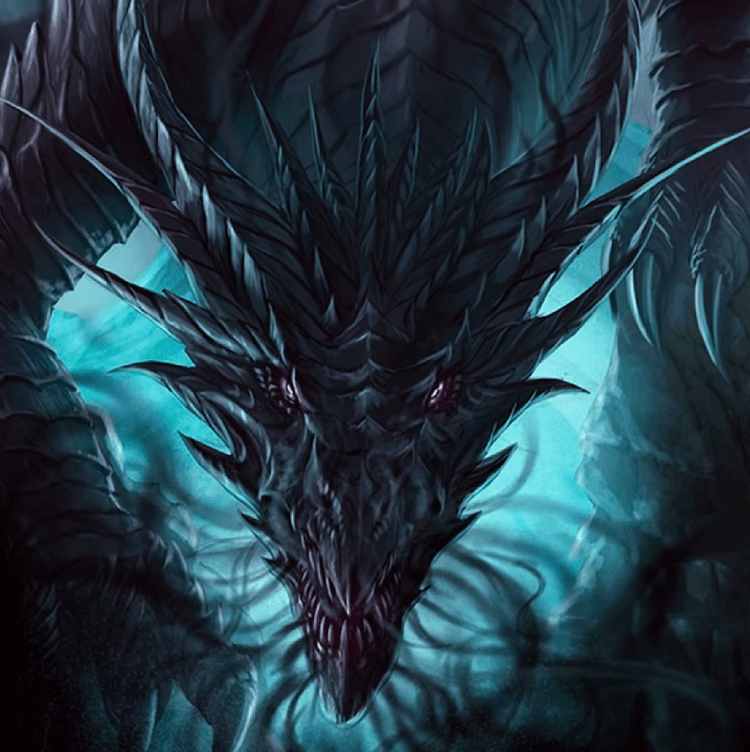
Unlike the typical monster, a Shadow Dragon is actually a monster template. A stat block in the monster manual is included for a Young Red Shadow Dragon.
Only a true dragon may be transformed or born as a Shadow Dragon. Dracholich have cast aside their draconic lineage and, as such, are excluded. Otherwise, this template can be applied to any true Chromatic, Metallic, or Gem dragon.
A transformed Shadow dragon will keep its previous statics unless otherwise stated below.
- Damage resistance to necrotic damage is gained.
- If in sunlight, a disadvantage is taken on attack rolls and sight perception checks.
- The dragon’s skill proficiency check for stealth is doubled.
- Living Shadow Only while in dim light or darkness does the dragon gain damage resistance to all forms of damage except force, radiant, or psychic.
- Shadow Stealth Dim-light or darkness allows the dragon to Hide using a bonus action.
- Bite If the dragon’s bite causes additional damage, such as fire or poison, this damage type is changed to necrotic.
- Shadow Breath: Damage dealing breath weapons have their damage type changed to necrotic.
If the enemy has its Hit Points reduced to 0 by Shadow Breath, they die. Then, an undead shadow controlled by the dragon rises from the enemy’s corpse. This shadow acts immediately after the dragon’s turn.
The stat block for an Undead Shadow is included below.
Undead Shadow Statblock
Medium Undead, Chaotic Evil
- CR 1/2
- Passive Perception 10
- AC: 12 Hit Points: 16 (3d8+3)
- Speed 40 ft
- Str 6 (-2) Dex 14 (+2) Con 13 (+1)
- Int 6 (-2) Wis 10 (+0) Cha 8 (-1)
- Skills: Stealth +4
- Dmg Vulnerabilities: Radiant
- Dmg Resist: Acid, Cold, Fire, Lightning, Thunder; nonmagical Bludgeoning, Piercing, and Slashing
- Dmg Immunities: Necrotic, Poison
- Condition Immunities: Exhaustion, Frightened, Grapple, Paralyze, Petrify, Poison, Prone, Restrained
- Senses: Dark-Vision 60 Feet
- Languages: None
- Amorphous: That humanoid figure of theirs is merely a memory of their former selves. Shadows can move through a space as narrow as one inch wide without squeezing.
- Shadow Stealth: Lighting conditions considered dim or lower allows the shadow to use the Hide skill as a bonus action.
- Sunlight Weakness: Sunlight disadvantages the shadow on saves, ability checks, and attack rolls.
- Strength Drain
- Roll to Hit: +4
- Range: Five Feet, Single Creature
- Hit: 9 (2d6+2) necrotic, 1d4 reduction to target’s Strength Score.
If the target’s strength is reduced to zero, they die immediately. This reduction will be removed upon finishing a short rest.
Should a target die to Strength Drain either by attack damage or strength reaching zero, a new shadow will rise in 1d4 hours.
Young Red Shadow Dragon Statblock
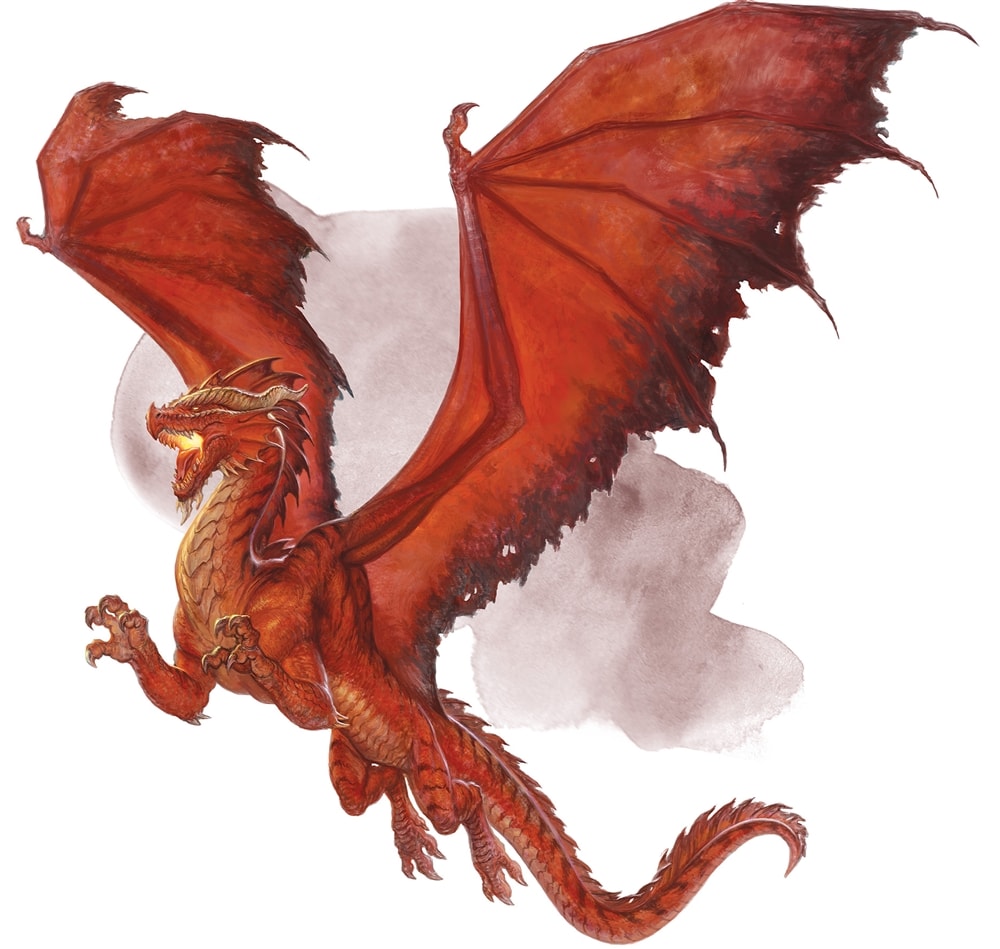
Large Dragon, Chaotic Evil
- CR 13 (10,000 XP)
- Passive Perception 18
- AC: 18 (natural armor) Hit Points: 178 (17d10+85)
- Speed 40 ft, climb 40 ft, fly 80 ft,
- Str 23 (+6) Dex 10 (+0) Con 21(+5)
- Int 14 (+2) Wis 11(+0) Cha 19(+4)
- Saving Throws: Dex +4, Con +9, Wis +4, Cha +8
- Skills: Perception +8, Stealth +8
- Senses: blindsight 30 ft, dark-vision 120 ft,
- Languages: Common, Draconic
- Living Shadow: The darkness protects a dragon. So long as the light is dim or lower, the dragon gains resistance to all damage. This excludes force, psionic, or radiant damage.
- Shadow Stealth: In dim or lower light, Hide can be used by a shadow dragon as a bonus action.
- Sunlight Sensitivity: Sunlight messes with the Shadow Dragon’s sight; it causes it to have a disadvantage on sight-related Perception (Wis) checks. It also takes a disadvantage on attack rolls.
- Multiattack: Three Attacks; One Bite and Two Claw
- Bite
- Roll to Hit: +10
- Range: Ten Feet, Single Target
- Hit: 17 (2d10+6) piercings + 3 (1d6) necrotic
- Claw
- Roll to Hit: +10
- Range: Five feet, single target
- Hit: 13 (2d6+6) slashing
- Shadow Breath
- Range: 30-ft cone
- Save: DC 18 Dex
- Hit: 56 (16d6) necrotic on fail, half on success.
Dropping to zero by this damage will cause immediate death. From the victim’s corpse, an undead shadow under the Shadow Dragon’s control will rise. Concerning initiative, the Undead Shadow will act immediately after the dragon.
Shadow Dragon Biology
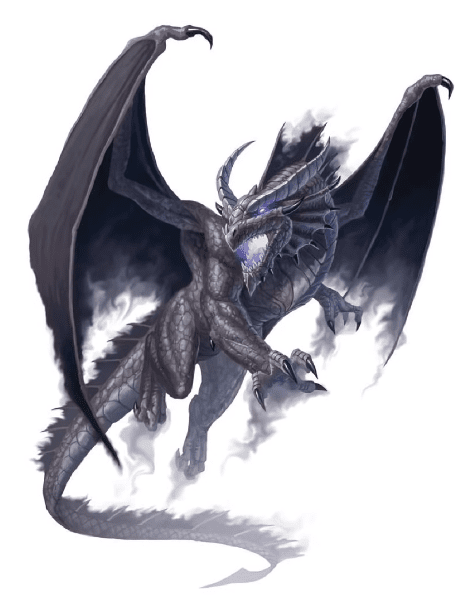
Being infused with the Planar energies of the Shadowfell, Shadow Dragons are strongest in dark conditions. Their scales resemble charcoal while keeping a faint metallic sheen.
Their wings are translucent and bleed into the shadows at their edges. Their eyes are an opalescent gray. Any color of their previous species has long faded into the darkness.
When cast in darkness, a Shadow Dragon looks like a spectral shadow.
While they can manage fresh food, they definitely do not prefer it. Being carrion hunters, finding a ditch or pit full of corpses somewhere in their lair is not unusual. This has proven to be a boon for many adventurers.
Rather than losing their friend to the stomach acid of a dragon immediately, the party can go on a rescue mission to retrieve the corpse for resurrection. Fortunately, the corpse takes some time to ripen to the dragon’s liking.
Breath Weapon
Their connection to the weave is corrupted. It is to the point that the dragon’s breath now acts as a new source for that corruption to spread. It is now a caustic plume of necrosis rather than the element the True Dragon used to emit.
The Shadow Dragon’s breath sucks the vitality out of its victims. The 5e stats DMs can prove this in gameplay by having every fail on a Shadow dragon’s breath weapon cause them to take a cumulative point of exhaustion.
Transformation
The process of a True Dragon transforming into a Shadow Dragon takes years. However, since the average power nap of a dragon ALSO spans multiple years, a dragon can wake up surprised to find out they have fully transformed.
Portals between the Material and Shadowfell can manifest in spots soaked sufficiently in sullen vibes or the deepest pits of dungeons and caverns soaked with the trauma of many lost adventurers. Sometimes, a dragon’s lair.
The plane of Shadowfell itself seems to crave dragons, their magical majesty being a mighty beast to drain. Even as the dragon witnesses their scales lose their color, the inherent nature of the Shadowfell will force an accepting malaise on the creature. They will watch themselves wither away and yet find themselves unable to care.
The Shadowfell will make them even lean into the shadowy saturation as the despair creeps through them the longer they linger. Once the transformation is complete, not even time spent on the Material will cause the corruption to fade.
Aging
Dragons do not falter to time like mortals might. While they seem immortal to a human, in reality, their lifespan does have a limit. While that exact limit is hard to track, it can be believed it is somewhere around 1500 years before the body begins to deteriorate from age.
A dragon goes through twelve stages in its life, similar to a human’s juvenile to elder stages. While it has since been simplified to five for mortal attention spans, the beginning and end are the same.
A dragon starts as a Wyrmling until five years old. Meanwhile, the last stage of life is Greatwyrm, a dragon over 1200 years of age.
A dragon grows more powerful as they mature. Their size often grows to match, with the largest reported at over one hundred feet in length.
Species of Dragon

The dragons found across the material planes are usually split between three categories, considered much like noble families.
Adventurers most often battle with Chromatic Dragons. These dragons, which include Red, Green, and similar spectrum separated species, are primarily aligned with evil, as their deity is the evil dragon queen Tiamat. They are infamous for their greed and malicious nature.
While Metallic Dragons are most often considered aligned with the forces of good. They have metal-separated species such as brass, platinum, and gold dragons. These dragons worship the just god Bahamut and are held in similar reverence for their wisdom and kindness.
The rarest of the three are the Gem dragons, including topaz, emerald, and Amythst dragons. A notably neutral family of dragons who, like the previous two, hail from a progenitor dragon. Unlike the other two, Sardior the Ruby Dragon is said to have died long ago. The first line of Gem dragons is believed to be born from the lesser deity’s corpse.
Now, you might wonder where Shadow Dragons fit into this.
Planar Dragons are rare to the Material but are the general category for a species of dragon found native or created continuously in another plane. Other Planar dragons include faerie dragons, astral dragons, and axial dragons.
However, while Shadow Dragons are primarily native to the Shadowfell, any of the previously mentioned dragons can be corrupted into a Shadow Dragon. They merely need to spend too much time in the Shadowfell or, for some reason but is noted as having happened more than once, eat a portal to the shadow plane.
The only type of dragon excluded is a Dracolich. This is because they are undead and have cast aside their draconic nature for greater, forbidden power. However, a Shadow Dragon can be turned into a Dracolich.
Drow Dragons
Drow Shadow Dragons were said to be born from a drow city where Shadow dragons had enslaved their populace. A race of Half-Shadow Dragon and Half-Drow was born. Seeking to rise from their station, they sought the power to separate yet fuse their halves into a far greater whole.
Drow Shadow dragons can indefinitely switch between a Shadow Dragon form and a Drow form. They have the benefits and weaknesses of both races. Half-Shadow Dragons born from Drow are noted as one of the few Half-Dragon unions with functional wings.
Inspired by their species’ most powerful known member, the first generation of Half Drow-Half Shadow Dragons are called Zekyl. However, dilution of the gene leads to further offspring losing their Half-Dragon classification. This species goes by the name Zar’ithra.
Shadow Dragon Behavior
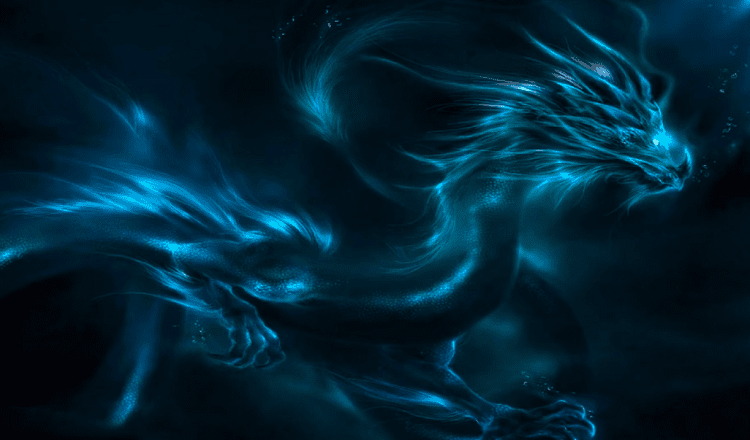
The corruption of the Shadowfell has made them innated paranoid of the light. The learning process accepts this change, as old habits and favored napping spots now prove uncomfortable if not painful for the creature.
Although the biting and clawing attacks that the dragon selected before corruption might still be helpful in close combat. A Shadow Dragon would still instead move from shadow to shadow while blasting a party with their Shadow Breath.
A Shadow Dragon good at this strategy will amass a large army of undead shadows, which will all ease the task of hunting and killing. Anyone seeking to hunt and kill a member of this species must be sure to account for a horde of undead Shadows. Even those times that they don’t initially appear to have any lumbering nearby.
They might be mighty and insanely powerful, but Shadow Dragons are stealthy above all else. Magic users can summon light, dispelling their darkness and blinding them with several spells.
A Dragon is not stuck to the ground, not even in a cave. Capable of climbing as fast as it walks, the beast will often cling to the top of a cavern, blending with the shadows in a spot torches can’t reach.
So rather than worrying about all that nonsense, a Shadow Dragon prefers to fight at a distance. Much like jungle cats, Shadow Dragons prefer to stalk their prey. Their communion with the shadows and their crafty tendencies make them one of the worst beasts to find yourself hunted by.
Close combat will only happen against their wishes; that is what their Undead Shadows are for.
A Shadow Dragon will first target spellcasters, then the strongest fighters, leaving the nonmagical ranged fighters for last.
Shadow Dragon Horde
Lit spaces are a known weakness to Shadow dragons, leading them to collect a horde of treasures fantasized about by roguish types across the Forgotten Realms. Items that cast darkness spells, invisibility potions, and charms that do a host of incredible shadow-related shenanigans are usually waiting for any who fell a Shadow Dragon.
Should the dragon not use it on themselves before you can manage.
Besides darkness producing magical items, the Shadow Dragon will collect dark-colored gems prioritizing ones that are not transparent. Some of these might not be precious stones, however, as they will also collect dark-colored stones and lava rocks they think look neat.
Manzzkyl Jaezred
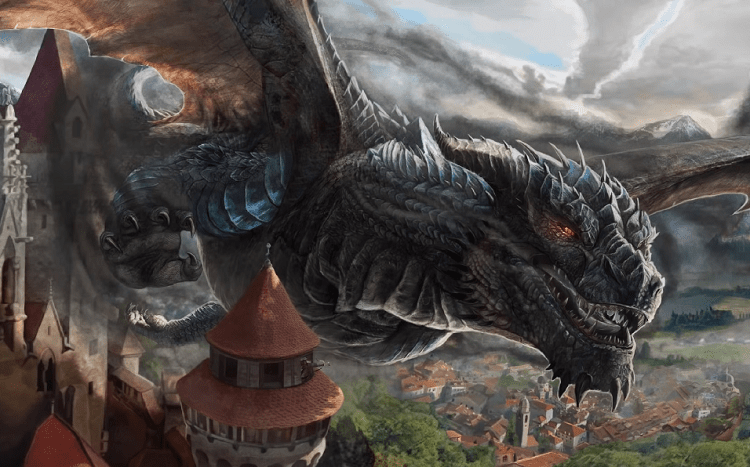
One of the very few CR 40 dragons and, sadly, the only one lacking a stat block. He is listed as a Great Wyrm Drow-Dragon. He is one of the strongest dragons alive and one of the most substantial known entities under the gods.
His status in the 3.5 lore states him as being living and having a sorcerer level of 13 and an assassin level of five. He is a Drow Shadow Dragon and is believed to have originally been a Black Dragon before taking steps to become a Shadow Dragon.
The Jaezred Chaulssin
Manzzkyl is the founder of an order of assassins comprised initially of the original enslaved Drow and their shadow dragon masters. This order has since grown to over 800 members.
Eight are noted as being Ancient Drow Shadow Dragons. These are considered his most robust, with a Cr 30 shadow dragon one of its few known leaders.
The Jaezred Chaulssin is an overwhelming force of chaos; thankfully, it is focused on Lolth and her followers.
The Jaezred Chaulssin challenged Lolth’s dominion over the Drow as it was a generally one-sided agreement. The base of this organization is the city of Chaulssin, noted for functioning in both the Shadowfell and Underdark as one unified city.
Manzzkyl and his followers focus on infiltrating Drow cities with their assassins guild. They will then, much like a rival religion might in the past, start killing the religious orders of Lolth and inspiring general chaos to sway favor towards him.
The ShadowFell
The Plane of Shadows; The Shadow Deep; Shadowland
At the beginning of creation, legends say the engineers of the Material created two mirror planes that acted as echos of the Prime Material. All that existed in the Prime Material has an echo in these two planes.
All the pieces of the plane considered too wildly bright were placed in the Fey Wylds. Meanwhile, all considered too dark and rotten were shunted to the Shadowfell.
Where the Fey Wylds will blind you with its peculiar beauty like a tapestry towards deadly and delightful creations, the Shadowfell exists as a monument to all that is bleak, barren, and broken. It will leave you corrupted either by the depressing desolation or the native necrotic energies weaved into its creation.
The Shadowfell and its inhabitants foster Negative Emotions to feed. Thankfully, unlike the Fey Wylds, the conditions required for a Shadowfell crossing leave far fewer portals to this depressing domain in the Material.
No light fills its skies as all the echoes of the Stars in the Material are already dead. Even the Black Holes clustering like galaxies with personal space feed on their lesser deceased brethren, the negative energies of the weave, and even cosmic terrors that only the Astral Behemouths can terrify.
One of the most well-known sections of the Shadowfell is located in one of the many pockets of mists that the Dark Powers of the Shadowfell have created. In this case, it stands as the home and possible prison of the infamous Strahd Von Zarovich and the setting of the Ravenloft Campaign, Barovia.
The corruption that changes a True Dragon to a Shadow Dragon is sourced here.
The Underdark

The Underdark is the name given by its resident to the mind-bogglingly massive web of tunnels and caverns that weave its way throughout the planet of Toril.
Under every central ‘World Above’ location set on this planet lies a tangled map of Mindflayer Colonies, Drow Civilizations, Disgraced Demons, and of course, Shadow Dragon Dens.
Not all locations were accessible from one another. The Underdark is divided into several domains. It functions much like the continents above, in a sense. It is further divided by the geography of the Underdark’s inner communities and winding parallel cavern clusters that may be congruent but not always connected.
The Upperdark accounts for the first three miles of underground terrain. For seven miles beneath the Upperdark lies the Middledark, where most of the cities and civilizations located themselves.
The worse beings could be found in the Lowerdark, Ten miles below the surface and beyond. Residents of the higher levels despise wandering these depths. Rifts to the Abyss, demons banished from the Era of Demons, and a mythical horde considered one of the richest in the realm buried in the equally heavily guarded Tomb Tapper Tomb.
FAQs
Question: What Type of DnD Dragon Would Make the Most Potent Species of Shadow Dragon?
Answer: This comes with two solutions. Both answers exclude specially named dragons, as their CR rating accounts for them being at the level of deities or acting as a monster of legend. We’re only accounting for Dragon Types here. That isn’t to say it isn’t possible.
The most common dragon species with the highest CR rating is unanimously the Greatwyrm Gold dragon. This is because they are considered the strongest of the metallic dragons and hold a revered reputation among their kin.
However, suppose you want something rarer but stronger. In that case, a species is only outmatched by a select few named dragons.
Prismatic Dragons are a rare Gem Dragon breed capable of splitting the magic weave itself into a frightening prismatic breath, which consisted of various colors that all held a different power.
This, of course, would be removed. In addition, other powerful inclusions to a Prismatic, such as its massive 30 strength, would all stray, making it the contender for the strongest shadow dragon species possible.
To put it in perspective, let us compare stat blocks.
In fifth edition only an Ancient Gold Dragon has a stat block; it stands at a CR 25. An official stat block on an Ancient Prismatic Dragon is difficult to find.
They exist in the Canon Lore but are unanimously considered too much of a pain to function. However, the ones I have found place an Ancient Prismatic Dragon at around 30 to 36, depending on the source.
Question: What Should My Party Do if Facing a Shadow Dragon in 5e DnD?
Answer: You are unlikely to fight a Shadow Dragon in favorable conditions, being sunlight. Unless you are the rare exception of a champion actively wielding force, radiant, or psionic damage, then you will desperately need to raise the light level.
The shadow Dragon will also actively flee the light spell’s radius, as a Shadow Dragon constantly moves through the shadows.
Focus on clearing any Undead Shadows as these creatures are not terribly strong but can cause a nightmarish problem as they can sap players of their strength. Next, protect your Spellcasters, as that will be the dragon’s first focus.
Cut off the Shadow Dragon as best as the party is capable of preventing him from fleeing or setting up choke points using multiple light-casting spells.
Question: What’s a Silly Way I Can Use Shadow Dragons in DnD 5e?
Answer: Inspired entirely by google’s insistence I meant a particular group from Dragonball GT; I got an idea. Seven dragons from seven different Chromatic species have each been affected by an achievement the party or its members have accomplished throughout your campaigns.
In their orneriness, they performed the Taboo. They allowed themselves to become turned into Shadow Dragons and rampage through the Material Planes. This is your problem now, as they are vocal about who pissed them off. Full villainous monologues.
Conclusion
In a game named after them, it can be excruciatingly hard to figure out what type of dragon to throw at your players. So, shadow dragons make it harder by giving you the option to make that dragon a corruptive headache to all parties involved.
They have been a staple to DnD monster manuals for a reason, though they might disagree between editions on if it is a specialized species or a corruptive template. The outcome is essentially the same, it is just the steps involved to tweak it to your hearts have been adjusted and tuned themselves.
Personally, I find the idea of a dragon that controls the very shadows around it while unleashing who knows what from their horde of magical ‘back off’ intimidating as I do inspiring.
That might be due to my favoring Maleficent as an animated Disney villain. I got my suspicions she started out as a Faerie Dragon.
- Blight 5e Guide: Blood-Thirsty Brambles - August 28, 2022
- Constructs 5e Guide: Intimidating Innovation - August 20, 2022
- Modrons 5e Guide - August 13, 2022

